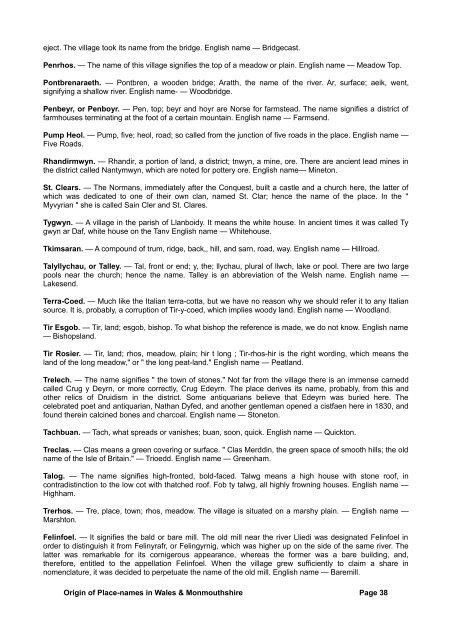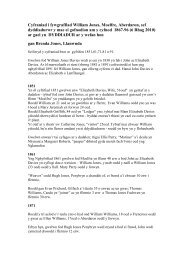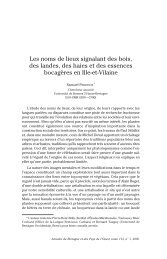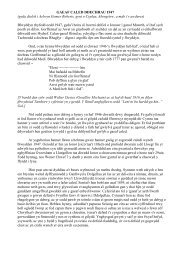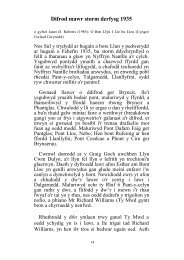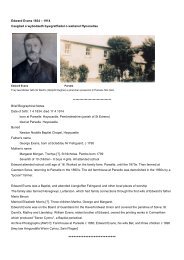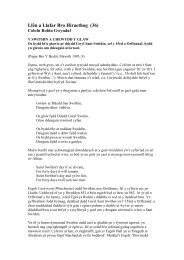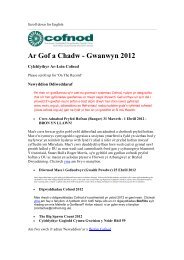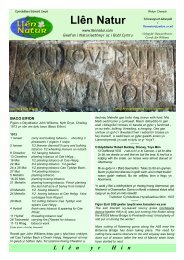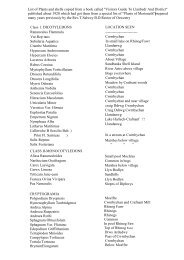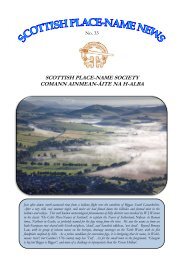Marros. — A mounta<strong>in</strong> <strong>in</strong> <strong>the</strong> parish is called Marros. The name signifies a wild, mounta<strong>in</strong>ous region, whichwas undoubtedly suggested by <strong>the</strong> physical aspect <strong>of</strong> <strong>the</strong> district. English name - Montham.Me<strong>in</strong>ciau .— A corruption, probably, <strong>of</strong> Mer-??? <strong>the</strong> edge <strong>of</strong> <strong>the</strong> field. Some th<strong>in</strong>k it is <strong>the</strong> plural <strong>of</strong> ??? abench imply<strong>in</strong>g elevated pieces <strong>of</strong> l<strong>and</strong>. English name— Highfield.Moelfre. — A compound <strong>of</strong> mod, bare, <strong>and</strong> b' yn y hill. English name — Barehill.Myddfai. — Mydd-tnedd, meadow ; fai-mai, a <strong>place</strong> or open field. The <strong>place</strong> is noted for its celebratedphysicians <strong>in</strong> <strong>the</strong> twelfth century. Meddygon M <strong>the</strong> physicians <strong>of</strong> Myddfai is a proverbial form. English name— Meadham.Mydrim. — Meidrum is <strong>the</strong> true orthographyMynachdy. — The name signifies a monastery It is supposed that a cell to some ancient abbey; that wassituated here sometime ; hence <strong>the</strong> name, ???, <strong>the</strong> church <strong>of</strong> <strong>the</strong> cross, <strong>the</strong> name <strong>of</strong> <strong>the</strong> parish was ??? <strong>the</strong><strong>place</strong> is <strong>of</strong> Roman <strong>orig<strong>in</strong></strong>. English name - Monkham.Nantgaredig. — Nant, brook; garedig, lov<strong>in</strong>g, k<strong>in</strong>d. English name— Lov<strong>in</strong>gbrook.Nantyca<strong>in</strong>. — Nant, brook; co<strong>in</strong>, clear, fair. English name — Clearbrook.Nantymwyn. — Mwyn, m<strong>in</strong>e, ore. Lead m<strong>in</strong>es abound <strong>in</strong> this district. English name — Leadbrook.Newcastle-Emlyn. — Op<strong>in</strong>ions differ as to <strong>the</strong> <strong>orig<strong>in</strong></strong> <strong>of</strong> this name. It is a translation <strong>of</strong> <strong>the</strong> Welsh Castellnewydd-Emlyn.The present castle was built on <strong>the</strong> site <strong>of</strong> <strong>the</strong> old one by Sir Rhys ap Thomas, <strong>in</strong> <strong>the</strong> reign <strong>of</strong>Henry VIII., hence <strong>the</strong> appellation Newcastle. Emlyn is variously derived. Some derive it from Emilianus, <strong>the</strong>name <strong>of</strong> a Roman nobleman that took up his abode here. O<strong>the</strong>rs derive it from <strong>the</strong> shape (llun) <strong>of</strong> <strong>the</strong> letter Mformed by <strong>the</strong> w<strong>in</strong>d<strong>in</strong>g course <strong>of</strong> <strong>the</strong> Teivi <strong>in</strong> <strong>the</strong> vic<strong>in</strong>ity <strong>of</strong> Newcastle, thus M tun, shape <strong>of</strong> <strong>the</strong> letter M. Themost plausible are <strong>the</strong> follow<strong>in</strong>g derivations :—E; -, am, round, about; lyn-glynu, to adhere, to cleave. Theriver encompasses <strong>the</strong> town, <strong>and</strong> its slowness <strong>in</strong>dicates, as it were, its preference to adhere to <strong>the</strong> town thanmake for its salty home. Ano<strong>the</strong>r attempt: Emyl, border or edge, add <strong>the</strong> particle yn to it, <strong>and</strong> <strong>the</strong>n we haveEmylyn; t omit <strong>the</strong> first y, <strong>and</strong> we have Emlyn, a borderer. Once more : Em, round; lyn, llyn, a lake, or a body<strong>of</strong> water, signify<strong>in</strong>g water-circled. English name — Newcastle- on-Teivi.Pantyffynon. — Pant, a low <strong>place</strong>; y, <strong>the</strong>; ffynon, a well; from a farm so called which is situated <strong>in</strong> a low<strong>place</strong>. English name — Wellton.Penrhiwgoch. — Pen, top; rhiw, slope; gock, red. The suffix coch forms a part <strong>of</strong> many <strong>names</strong> <strong>in</strong> <strong>the</strong> district,as Garreg-goch, red-stone; Ffynon-goch, red-well,
eject. The village took its name from <strong>the</strong> bridge. English name — Bridgecast.Penrhos. — The name <strong>of</strong> this village signifies <strong>the</strong> top <strong>of</strong> a meadow or pla<strong>in</strong>. English name — Meadow Top.Pontbrenaraeth. — Pontbren, a wooden bridge; Aratth, <strong>the</strong> name <strong>of</strong> <strong>the</strong> river. Ar, surface; aeik, went,signify<strong>in</strong>g a shallow river. English name- — Woodbridge.Penbeyr, or Penboyr. — Pen, top; beyr <strong>and</strong> hoyr are Norse for farmstead. The name signifies a district <strong>of</strong>farmhouses term<strong>in</strong>at<strong>in</strong>g at <strong>the</strong> foot <strong>of</strong> a certa<strong>in</strong> mounta<strong>in</strong>. English name — Farmsend.Pump Heol. — Pump, five; heol, road; so called from <strong>the</strong> junction <strong>of</strong> five roads <strong>in</strong> <strong>the</strong> <strong>place</strong>. English name —Five Roads.Rh<strong>and</strong>irmwyn. — Rh<strong>and</strong>ir, a portion <strong>of</strong> l<strong>and</strong>, a district; tnwyn, a m<strong>in</strong>e, ore. There are ancient lead m<strong>in</strong>es <strong>in</strong><strong>the</strong> district called Nantymwyn, which are noted for pottery ore. English name— M<strong>in</strong>eton.St. Clears. — The Normans, immediately after <strong>the</strong> Conquest, built a castle <strong>and</strong> a church here, <strong>the</strong> latter <strong>of</strong>which was dedicated to one <strong>of</strong> <strong>the</strong>ir own clan, named St. Clar; hence <strong>the</strong> name <strong>of</strong> <strong>the</strong> <strong>place</strong>. In <strong>the</strong> "Myvyrian " she is called Sa<strong>in</strong> Cler <strong>and</strong> St. Clares.Tygwyn. — A village <strong>in</strong> <strong>the</strong> parish <strong>of</strong> Llanboidy. It means <strong>the</strong> white house. In ancient times it was called Tygwyn ar Daf, white house on <strong>the</strong> Tanv English name — Whitehouse.Tkimsaran. — A compound <strong>of</strong> trum, ridge, back,, hill, <strong>and</strong> sarn, road, way. English name — Hillroad.Talyllychau, or Talley. — Tal, front or end; y, <strong>the</strong>; llychau, plural <strong>of</strong> llwch, lake or pool. There are two largepools near <strong>the</strong> church; hence <strong>the</strong> name. Talley is an abbreviation <strong>of</strong> <strong>the</strong> Welsh name. English name —Lakesend.Terra-Coed. — Much like <strong>the</strong> Italian terra-cotta, but we have no reason why we should refer it to any Italiansource. It is, probably, a corruption <strong>of</strong> Tir-y-coed, which implies woody l<strong>and</strong>. English name — Woodl<strong>and</strong>.Tir Esgob. — Tir, l<strong>and</strong>; esgob, bishop. To what bishop <strong>the</strong> reference is made, we do not know. English name— Bishopsl<strong>and</strong>.Tir Rosier. — Tir, l<strong>and</strong>; rhos, meadow, pla<strong>in</strong>; hir t long ; Tir-rhos-hir is <strong>the</strong> right word<strong>in</strong>g, which means <strong>the</strong>l<strong>and</strong> <strong>of</strong> <strong>the</strong> long meadow," or " <strong>the</strong> long peat-l<strong>and</strong>." English name — Peatl<strong>and</strong>.Trelech. — The name signifies " <strong>the</strong> town <strong>of</strong> stones." Not far from <strong>the</strong> village <strong>the</strong>re is an immense carneddcalled Crug y Deyrn, or more correctly, Crug Edeyrn. The <strong>place</strong> derives its name, probably, from this <strong>and</strong>o<strong>the</strong>r relics <strong>of</strong> Druidism <strong>in</strong> <strong>the</strong> district. Some antiquarians believe that Edeyrn was buried here. Thecelebrated poet <strong>and</strong> antiquarian, Nathan Dyfed, <strong>and</strong> ano<strong>the</strong>r gentleman opened a cistfaen here <strong>in</strong> 1830, <strong>and</strong>found <strong>the</strong>re<strong>in</strong> calc<strong>in</strong>ed bones <strong>and</strong> charcoal. English name — Stoneton.Tachbuan. — Tach, what spreads or vanishes; buan, soon, quick. English name — Quickton.Treclas. — Clas means a green cover<strong>in</strong>g or surface. " Clas Merdd<strong>in</strong>, <strong>the</strong> green space <strong>of</strong> smooth hills; <strong>the</strong> oldname <strong>of</strong> <strong>the</strong> Isle <strong>of</strong> Brita<strong>in</strong>." — Trioedd. English name — Greenham.Talog. — The name signifies high-fronted, bold-faced. Talwg means a high house with stone ro<strong>of</strong>, <strong>in</strong>contradist<strong>in</strong>ction to <strong>the</strong> low cot with thatched ro<strong>of</strong>. Fob ty talwg, all highly frown<strong>in</strong>g houses. English name —Highham.Trerhos. — Tre, <strong>place</strong>, town; rhos, meadow. The village is situated on a marshy pla<strong>in</strong>. — English name —Marshton.Fel<strong>in</strong>foel. — It signifies <strong>the</strong> bald or bare mill. The old mill near <strong>the</strong> river Lliedi was designated Fel<strong>in</strong>foel <strong>in</strong>order to dist<strong>in</strong>guish it from Fel<strong>in</strong>yrafr, or Fel<strong>in</strong>gyrnig, which was higher up on <strong>the</strong> side <strong>of</strong> <strong>the</strong> same river. Thelatter was remarkable for its cornigerous appearance, whereas <strong>the</strong> former was a bare build<strong>in</strong>g, <strong>and</strong>,<strong>the</strong>refore, entitled to <strong>the</strong> appellation Fel<strong>in</strong>foel. When <strong>the</strong> village grew sufficiently to claim a share <strong>in</strong>nomenclature, it was decided to perpetuate <strong>the</strong> name <strong>of</strong> <strong>the</strong> old mill. English name — Baremill.Orig<strong>in</strong> <strong>of</strong> Place-<strong>names</strong> <strong>in</strong> Wales & Monmouthshire Page 38
- Page 1 and 2: HANDBOOK OF THE ORIGIN OF PLACE-NAM
- Page 3 and 4: § § § § §The Author begs to st
- Page 5 and 6: pitiful cries of the railway offici
- Page 7 and 8: Bishop Percy says that "in England,
- Page 9 and 10: The city of Chester is still popula
- Page 11 and 12: There's Cumwhitton, Cumwhinton, Cum
- Page 13 and 14: Llwyn in its primary' sense means a
- Page 15 and 16: PLACE-NAMES IN WALES.Wales. — The
- Page 17 and 18: Church are generally dedicated to e
- Page 19 and 20: think he was a contemporary of St.
- Page 21 and 22: Rhosbeirio. — Rhos, a moor, a dry
- Page 23 and 24: of Brecknock," states that this vic
- Page 25 and 26: Cam cnwir ef Cwmdu,Cwm gwyn yw & n
- Page 27 and 28: Penderyn. — A corruption probably
- Page 29 and 30: Ardudwy. — Ar, upon or above; tud
- Page 31 and 32: to mark its pre-eminence over the o
- Page 33 and 34: Some think that eirw is a corruptio
- Page 35 and 36: present form — Caerfyrddin.Abergw
- Page 37 and 38: place of refuge; hence the name. En
- Page 39: Llansawyl. — The church was dedic
- Page 43 and 44: house, and attempted to kill an inf
- Page 45 and 46: Gwydir. — Prima facie one may tak
- Page 47 and 48: Nefyn. — The church was probably
- Page 49 and 50: DENBIGHSHIRE.Anglicized form of Din
- Page 51 and 52: Llangollen. — From Collen, a sain
- Page 53 and 54: hands into their pockets to pay a c
- Page 55 and 56: Cefn. — The name signifies a ridg
- Page 57 and 58: Maesgarmon. — Named in honour of
- Page 59 and 60: Abertridwr. — Tridwr, three water
- Page 61 and 62: it is said, was originally built by
- Page 63 and 64: Cwmllynfell. — Cwm, a narrow vale
- Page 65 and 66: Gwarycaeau. — Gwdr, the nape of t
- Page 67 and 68: means a cultivated region, a vale,
- Page 69 and 70: Penrhiwfer.- Pen, head, top; rhiw,
- Page 71 and 72: Port Talbot. — So called in 1835
- Page 73 and 74: Trealaw. — This appellation was g
- Page 75 and 76: Aberdyfi. — So called from its si
- Page 77 and 78: Llanddwywe. — From Dwywau, a desc
- Page 79 and 80: Crickhowell and some in the directi
- Page 81 and 82: Griffithstown. — This village was
- Page 83 and 84: and gwy, water. Treiddiod troth tna
- Page 85 and 86: derive Tintern from din, fortified
- Page 87 and 88: Caersws. — It appears that the Ro
- Page 89 and 90: English name — Ervylton.Llanymech
- Page 91 and 92:
Angle. — Probably from the angle-
- Page 93 and 94:
Gellyswick. — Another hybrid. Gel
- Page 95 and 96:
that the two rivers in their flowin
- Page 97 and 98:
ecame the bishop of the see, and wa
- Page 99 and 100:
earth formerly stood on a summit on
- Page 101 and 102:
Pilleth. — A corruption of pwll,
- Page 103 and 104:
Howells, Rev. J., Mountain AshHowel
- Page 105 and 106:
Williams, D., PenywernWilliams, Rev


